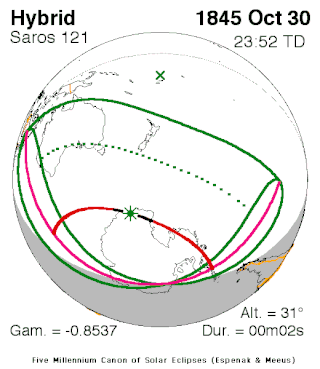Solar eclipse of October 30, 1845
This article has multiple issues. Please help improve it or discuss these issues on the talk page. (Learn how and when to remove these messages)
|
| Solar eclipse of October 30, 1845 | |
|---|---|
| Type of eclipse | |
| Nature | Hybrid |
| Gamma | −0.8538 |
| Magnitude | 1.0005 |
| Maximum eclipse | |
| Duration | 2 s (0 min 2 s) |
| Coordinates | 69°06′S 144°30′E / 69.1°S 144.5°E |
| Max. width of band | 3 km (1.9 mi) |
| Times (UTC) | |
| Greatest eclipse | 23:51:58 |
| References | |
| Saros | 121 (51 of 71) |
| Catalog # (SE5000) | 9153 |
A total solar eclipse occurred at the Moon's ascending node of orbit between Thursday, October 30 and Friday, October 31, 1845, with a magnitude of 1.0005. It was a hybrid event, with only a fraction of its path as total, and longer sections at the start and end as an annular eclipse. A solar eclipse occurs when the Moon passes between Earth and the Sun, thereby totally or partly obscuring the image of the Sun for a viewer on Earth. A total solar eclipse occurs when the Moon's apparent diameter is larger than the Sun's, blocking all direct sunlight, turning day into darkness. Totality occurs in a narrow path across Earth's surface, with the partial solar eclipse visible over a surrounding region thousands of kilometres wide. Occurring about 3.4 days before perigee (on November 3, 1845, at 10:40 UTC), the Moon's apparent diameter was larger.[1]
The greatest eclipse was in northeasternmost Antarctica south of where the Indian and Pacific Ocean divides at 69.1 S and 144.5 E at 23:51 UTC (9:51 am on October 31), in that portion of Antarctica and the surrounding waters it shown as a total eclipse, the remainder was as an annular, first in the Indian Ocean then in the Antarctic Peninsula.[2]
Description
[edit]The eclipse was visible in the islands of Java, Bali, Sunda (the three compromising a part of Indonesia today) and Timor including Portuguese Timor (now East Timor), the Asian islands, almost the whole of Australia with the exception of the Cape York Peninsula, Lord Howe Island, Norfolk Island, Macquarrie Islands, New Zealand, Chatham Islands, Antipodes and some remaining small islands.
In Australia, it showed up to 10% obscuration in the south of the Gulf of Carpentaria, around 15% in Brisbane, 25–30% in Central Australia, around 40% in Sydney, 50% in Melbourne, around 55% in Tasmania and the Nullarbor Plain and around 60% in Perth, Western Australia. Elsewhere it showed 10% in the north tip of New Zealand's North Island, up to 30% in the area of Wellington, 45% in Otago. and 60% in the Chatham Islands. It was also around 90% in the shores of Western Antarctica and around the 180th meridian.
The rim of the eclipse included the area south of Cairns, Queensland, the Coral Sea and Cook Islands.
The eclipse started at sunrise in Western Australia and finished at sunset in the Antarctic Peninsula and southwest of Patagonia in South America.[2]
Eclipse details
[edit]Shown below are two tables displaying details about this particular solar eclipse. The first table outlines times at which the moon's penumbra or umbra attains the specific parameter, and the second table describes various other parameters pertaining to this eclipse.[3]
| Event | Time (UTC) |
|---|---|
| First Penumbral External Contact | 1845 October 30 at 21:32:18.1 UTC |
| First Umbral External Contact | 1845 October 30 at 22:55:30.0 UTC |
| First Central Line | 1845 October 30 at 22:55:59.9 UTC |
| Greatest Duration | 1845 October 30 at 22:55:59.9 UTC |
| First Umbral Internal Contact | 1845 October 30 at 22:56:30.0 UTC |
| Ecliptic Conjunction | 1845 October 30 at 23:42:49.2 UTC |
| Greatest Eclipse | 1845 October 30 at 23:51:57.4 UTC |
| Equatorial Conjunction | 1845 October 31 at 00:13:51.7 UTC |
| Last Umbral Internal Contact | 1845 October 31 at 00:47:11.4 UTC |
| Last Central Line | 1845 October 31 at 00:47:38.9 UTC |
| Last Umbral External Contact | 1845 October 31 at 00:48:06.2 UTC |
| Last Penumbral External Contact | 1845 October 31 at 02:11:21.2 UTC |
| Parameter | Value |
|---|---|
| Eclipse Magnitude | 1.00046 |
| Eclipse Obscuration | 1.00092 |
| Gamma | −0.85375 |
| Sun Right Ascension | 14h20m21.2s |
| Sun Declination | -14°00'22.1" |
| Sun Semi-Diameter | 16'07.2" |
| Sun Equatorial Horizontal Parallax | 08.9" |
| Moon Right Ascension | 14h19m33.4s |
| Moon Declination | -14°49'00.4" |
| Moon Semi-Diameter | 15'59.8" |
| Moon Equatorial Horizontal Parallax | 0°58'42.5" |
| ΔT | 6.2 s |
Eclipse season
[edit]This eclipse is part of an eclipse season, a period, roughly every six months, when eclipses occur. Only two (or occasionally three) eclipse seasons occur each year, and each season lasts about 35 days and repeats just short of six months (173 days) later; thus two full eclipse seasons always occur each year. Either two or three eclipses happen each eclipse season. In the sequence below, each eclipse is separated by a fortnight.
| October 30 Ascending node (new moon) |
November 14 Descending node (full moon) |
|---|---|
 |
|
| Hybrid solar eclipse Solar Saros 121 |
Partial lunar eclipse Lunar Saros 133 |
Related eclipses
[edit]Eclipses in 1845
[edit]- An annular solar eclipse on May 6.
- A total lunar eclipse on May 21.
- A hybrid solar eclipse on October 30.
- A partial lunar eclipse on November 14.
Metonic
[edit]- Preceded by: Solar eclipse of January 11, 1842
- Followed by: Solar eclipse of August 18, 1849
Tzolkinex
[edit]- Preceded by: Solar eclipse of September 18, 1838
- Followed by: Solar eclipse of December 11, 1852
Half-Saros
[edit]- Preceded by: Lunar eclipse of October 24, 1836
- Followed by: Lunar eclipse of November 4, 1854
Tritos
[edit]- Preceded by: Solar eclipse of November 30, 1834
- Followed by: Solar eclipse of September 29, 1856
Solar Saros 121
[edit]- Preceded by: Solar eclipse of October 20, 1827
- Followed by: Solar eclipse of November 11, 1863
Inex
[edit]- Preceded by: Solar eclipse of November 19, 1816
- Followed by: Solar eclipse of October 10, 1874
Triad
[edit]- Preceded by: Solar eclipse of December 30, 1758
- Followed by: Solar eclipse of August 31, 1932
Solar eclipses of 1844–1848
[edit]This eclipse is a member of a semester series. An eclipse in a semester series of solar eclipses repeats approximately every 177 days and 4 hours (a semester) at alternating nodes of the Moon's orbit.[4]
The partial solar eclipses on June 16, 1844 and December 9, 1844 occur in the previous lunar year eclipse set, and the partial solar eclipses on March 5, 1848 and August 28, 1848 occur in the next lunar year eclipse set.
| Solar eclipse series sets from 1844 to 1848 | ||||||
|---|---|---|---|---|---|---|
| Ascending node | Descending node | |||||
| Saros | Map | Gamma | Saros | Map | Gamma | |
| 111 | November 10, 1844 Partial |
−1.4902 | 116 | May 6, 1845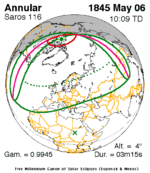 Annular |
0.9945 | |
| 121 | October 30, 1845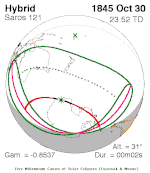 Hybrid |
−0.8538 | 126 | April 25, 1846 Hybrid |
0.2038 | |
| 131 | October 20, 1846 Annular |
−0.1506 | 136 | April 15, 1847 Total |
−0.5339 | |
| 141 | October 9, 1847 Annular |
0.5774 | 146 | April 3, 1848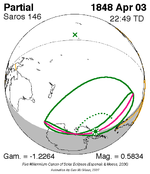 Partial |
−1.2264 | |
| 151 | September 27, 1848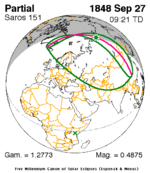 Partial |
1.2774 | ||||
Saros 121
[edit]This eclipse is a part of Saros series 121, repeating every 18 years, 11 days, and containing 71 events. The series started with a partial solar eclipse on April 25, 944 AD. It contains total eclipses from July 10, 1070 through October 9, 1809; hybrid eclipses on October 20, 1827 and October 30, 1845; and annular eclipses from November 11, 1863 through February 28, 2044. The series ends at member 71 as a partial eclipse on June 7, 2206. Its eclipses are tabulated in three columns; every third eclipse in the same column is one exeligmos apart, so they all cast shadows over approximately the same parts of the Earth.
The longest duration of totality was produced by member 39 at 6 minutes, 20 seconds on June 21, 1629, and the longest duration of annularity will be produced by member 62 at 2 minutes, 27 seconds on February 28, 2044. All eclipses in this series occur at the Moon’s ascending node of orbit.[5]
| Series members 49–70 occur between 1801 and 2200: | ||
|---|---|---|
| 49 | 50 | 51 |
 October 9, 1809 |
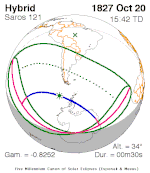 October 20, 1827 |
 October 30, 1845 |
| 52 | 53 | 54 |
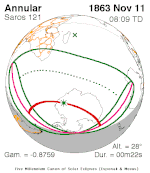 November 11, 1863 |
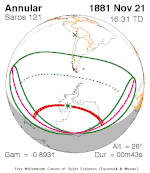 November 21, 1881 |
 December 3, 1899 |
| 55 | 56 | 57 |
 December 14, 1917 |
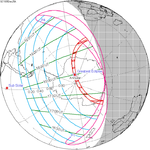 December 25, 1935 |
 January 5, 1954 |
| 58 | 59 | 60 |
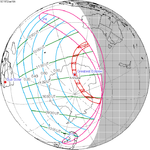 January 16, 1972 |
 January 26, 1990 |
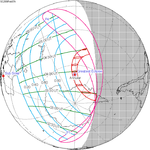 February 7, 2008 |
| 61 | 62 | 63 |
 February 17, 2026 |
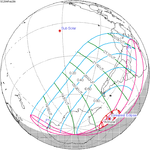 February 28, 2044 |
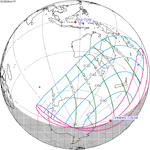 March 11, 2062 |
| 64 | 65 | 66 |
 March 21, 2080 |
 April 1, 2098 |
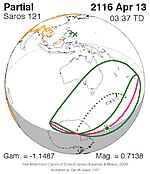 April 13, 2116 |
| 67 | 68 | 69 |
 April 24, 2134 |
 May 4, 2152 |
 May 16, 2170 |
| 70 | ||
 May 26, 2188 | ||
Metonic series
[edit]The metonic series repeats eclipses every 19 years (6939.69 days), lasting about 5 cycles. Eclipses occur in nearly the same calendar date. In addition, the octon subseries repeats 1/5 of that or every 3.8 years (1387.94 days). All eclipses in this table occur at the Moon's ascending node.
| 24 eclipse events between March 25, 1819 and August 20, 1906 | ||||
|---|---|---|---|---|
| March 25–26 | January 11–12 | October 30–31 | August 18–20 | June 6–7 |
| 107 | 109 | 111 | 113 | 115 |
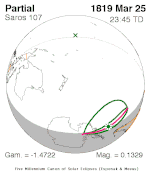 March 25, 1819 |
 January 12, 1823 |
 October 31, 1826 |
 August 18, 1830 |
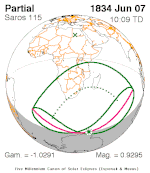 June 7, 1834 |
| 117 | 119 | 121 | 123 | 125 |
 March 25, 1838 |
 January 11, 1842 |
 October 30, 1845 |
 August 18, 1849 |
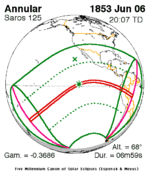 June 6, 1853 |
| 127 | 129 | 131 | 133 | 135 |
 March 25, 1857 |
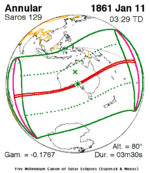 January 11, 1861 |
 October 30, 1864 |
 August 18, 1868 |
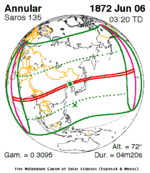 June 6, 1872 |
| 137 | 139 | 141 | 143 | 145 |
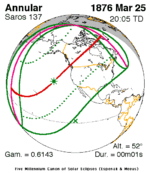 March 25, 1876 |
 January 11, 1880 |
 October 30, 1883 |
 August 19, 1887 |
 June 6, 1891 |
| 147 | 149 | 151 | 153 | |
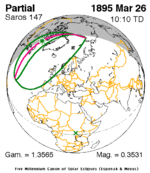 March 26, 1895 |
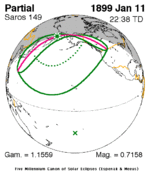 January 11, 1899 |
 October 31, 1902 |
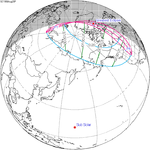 August 20, 1906 | |
Tritos series
[edit]This eclipse is a part of a tritos cycle, repeating at alternating nodes every 135 synodic months (≈ 3986.63 days, or 11 years minus 1 month). Their appearance and longitude are irregular due to a lack of synchronization with the anomalistic month (period of perigee), but groupings of 3 tritos cycles (≈ 33 years minus 3 months) come close (≈ 434.044 anomalistic months), so eclipses are similar in these groupings.
| Series members between 1801 and 2200 | ||||
|---|---|---|---|---|
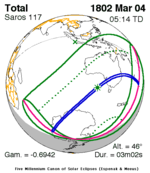 March 4, 1802 (Saros 117) |
 February 1, 1813 (Saros 118) |
 January 1, 1824 (Saros 119) |
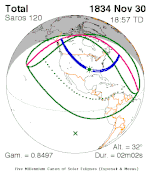 November 30, 1834 (Saros 120) |
 October 30, 1845 (Saros 121) |
 September 29, 1856 (Saros 122) |
 August 29, 1867 (Saros 123) |
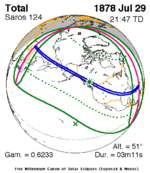 July 29, 1878 (Saros 124) |
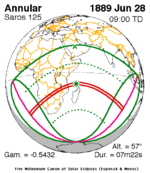 June 28, 1889 (Saros 125) |
 May 28, 1900 (Saros 126) |
 April 28, 1911 (Saros 127) |
 March 28, 1922 (Saros 128) |
 February 24, 1933 (Saros 129) |
 January 25, 1944 (Saros 130) |
 December 25, 1954 (Saros 131) |
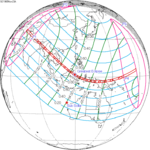 November 23, 1965 (Saros 132) |
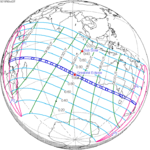 October 23, 1976 (Saros 133) |
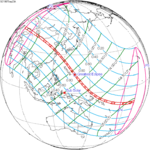 September 23, 1987 (Saros 134) |
 August 22, 1998 (Saros 135) |
 July 22, 2009 (Saros 136) |
 June 21, 2020 (Saros 137) |
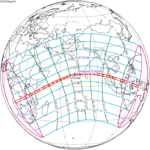 May 21, 2031 (Saros 138) |
 April 20, 2042 (Saros 139) |
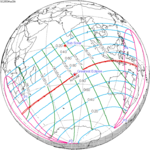 March 20, 2053 (Saros 140) |
 February 17, 2064 (Saros 141) |
 January 16, 2075 (Saros 142) |
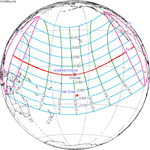 December 16, 2085 (Saros 143) |
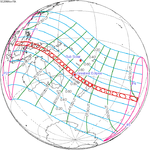 November 15, 2096 (Saros 144) |
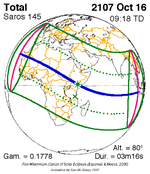 October 16, 2107 (Saros 145) |
 September 15, 2118 (Saros 146) |
 August 15, 2129 (Saros 147) |
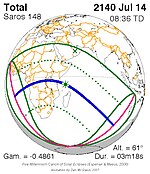 July 14, 2140 (Saros 148) |
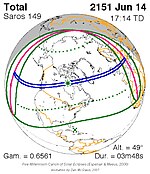 June 14, 2151 (Saros 149) |
 May 14, 2162 (Saros 150) |
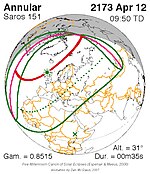 April 12, 2173 (Saros 151) |
 March 12, 2184 (Saros 152) |
 February 10, 2195 (Saros 153) | |||
Inex series
[edit]This eclipse is a part of the long period inex cycle, repeating at alternating nodes, every 358 synodic months (≈ 10,571.95 days, or 29 years minus 20 days). Their appearance and longitude are irregular due to a lack of synchronization with the anomalistic month (period of perigee). However, groupings of 3 inex cycles (≈ 87 years minus 2 months) comes close (≈ 1,151.02 anomalistic months), so eclipses are similar in these groupings.
| Series members between 1801 and 2200 | ||
|---|---|---|
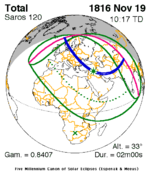 November 19, 1816 (Saros 120) |
 October 30, 1845 (Saros 121) |
 October 10, 1874 (Saros 122) |
 September 21, 1903 (Saros 123) |
 August 31, 1932 (Saros 124) |
 August 11, 1961 (Saros 125) |
 July 22, 1990 (Saros 126) |
 July 2, 2019 (Saros 127) |
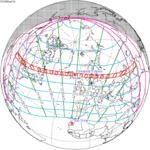 June 11, 2048 (Saros 128) |
 May 22, 2077 (Saros 129) |
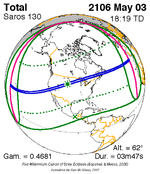 May 3, 2106 (Saros 130) |
 April 13, 2135 (Saros 131) |
 March 23, 2164 (Saros 132) |
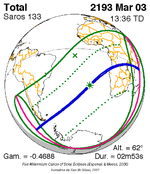 March 3, 2193 (Saros 133) |
|
See also
[edit]References
[edit]- ^ "Moon Distances for London, United Kingdom, England". timeanddate. Retrieved September 20, 2024.
- ^ a b "Solar eclipse of October 30, 1845". NASA. Retrieved March 18, 2017.
- ^ "Hybrid Solar Eclipse of 1845 Oct 30". EclipseWise.com. Retrieved September 20, 2024.
- ^ van Gent, R.H. "Solar- and Lunar-Eclipse Predictions from Antiquity to the Present". A Catalogue of Eclipse Cycles. Utrecht University. Retrieved October 6, 2018.
- ^ "NASA - Catalog of Solar Eclipses of Saros 121". eclipse.gsfc.nasa.gov.

